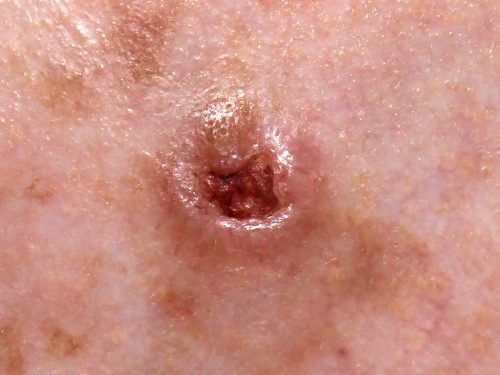Basal Cell Carcinoma
Basal cell carcinoma (BCC) is the most common skin cancer. It is abnormal, uncontrolled lesion that arises in the skin’s basal cells, which line the deepest layer of the epidermis (the outermost layer of the skin).
It presents as sores, red patches, pink growths, shiny bumps, or scars and is usually caused by a combination of cumulative and intense, occasional sun exposure. BCC almost never spreads (metastasizes) beyond the original tumor site.

Basal cell carcinoma SURGERY – FACTS
| Length of surgery | 30-90 minutes |
| Anaesthesia | General or local anaesthetic |
| Hospital stay | Day case |
| Risks/complications of surgery | Frequent: Swelling, bruising, temporary numbness stiffness, discomfort on movement Infrequent: Infection, unsightly scarring, bleeding (haematoma), wound healing problems, permanent numbness, incomplete excision, flap/graft loss |
| Recovery | 5 days facial sutures removed |
| Driving | 1-7 days |
| Follow up | 2 weeks, 6 weeks, 3 months |
| Duration of results | Permanent unless recurrence |
DOWNLOAD FURTHER INFORMATION
Basal Cell Carcinoma
Any plastic surgery procedure is a very personal choice and understandably there are a number of questions that arise. This information sheet is a general guide for patients considering basal cell carcinoma treatment under the care of Dr Mackenzie. It should provide the answers to some questions that you may have.
What is basal cell carcinoma?
Basal cell carcinoma (BCC) is the most common, locally invasive, keratinocytic non-melanoma skin cancer. It is also known as rodent ulcer. It rarely spreads to other parts of the body or kills but it can cause significant destruction and disfigurement by invading surrounding tissues.
What are the risk factors for BCC?
The main risks factors for developing BCC are:
- Long term sun exposure
- Older age
- Gender-more common in male patients
- Fair skin, blue or green eyes, blond or red hair
- Previous skin cancer
- Sun damage-actinic keratosis
- Previous cutaneous injury-thermal burn, lupus, sebaceous naevus
- Immunosuppression
- Ionising radiation and exposure to arsenic
- Family history
Who is more likely to develop BCC?
The following groups of people are at greater risk of developing the BCC:
- Immunosuppressed patients
- People who have had significant long term ultraviolet light exposure
- People susceptible to sunburn
- People who use sun beds regularly
- People with inherited syndromes-Gorlin syndrome, xeroderma pigmentosum, Bazex-Dupre-Christol syndrome